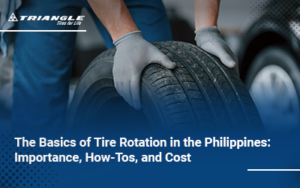As a driver in the Philippines, you know that keeping your vehicle in top shape is not just because you care about its performance. Rather, you recognize the importance of safety on the road. Government-mandated inspections play a vital role in ensuring that every car on the streets meets essential safety standards.
In this blog, you’ll discover everything you need to know about Private Motor Vehicle Inspection Centers (PMVIC). We’ll explain how these centers work, why they’re important for your vehicle’s upkeep, and how they help maintain road safety. Let’s dive in and see how PMVIC impacts your driving experience and what steps you can take to stay compliant and safe.
PMVIC Meaning Explained
Private Motor Vehicle Inspection Centers (PMVICs) are privately owned, automated facilities that certify whether vehicles comply with stringent emission standards and roadworthiness criteria before registration renewal.
Unlike traditional emission testing centers that offer basic inspections, PMVICs utilize modern technology and state-of-the-art equipment to ensure a fast, efficient, and accurate check.
They also digitize all license holders’ and vehicle owners’ data into one interconnected database, enhancing the integrity and transparency of the inspection process.
With minimal human intervention, PMVICs help reduce corruption and streamline testing to about 15 minutes per vehicle, saving you time and unnecessary fees. Plus, with their advanced safety features, these inspections enhance overall road safety in the Philippines.
A Step-by-Step Guide to the LTO MVIC
The whole LTO MVIC process can initially seem overwhelming, but with some preparation, you can breeze through the inspection and keep your vehicle roadworthy. Follow this step-by-step guide to ensure you’re fully prepared before, during, and after your PMVIC appointment.
1. Find an accredited PMVIC near you
Visit the official list of operational PMVICs provided by the LTO to find a facility closest to you. Look for one with convenient hours and good reviews, which can help minimize any stress on inspection day. When choosing an inspection facility, ensure it is an accredited MVIC (Motor Vehicle Inspection Center) LTO location to guarantee accurate testing and compliance with government regulations.
2. Schedule an appointment
While some centers may accept walk-ins, it’s best to book an appointment online as it can save you waiting time and ensure a smoother process. If you prefer to walk in, head to an encoder window with your OR/CR and vehicle identification number (VIN) to get your queue number.
3. Prepare your vehicle for inspection
Before heading to the PMVIC, inspect your vehicle to address any issues beforehand. Here’s a checklist to guide you:
– Visual inspection: Ensure your vehicle’s exterior and interior are clean and free of obvious damage.
– Brakes and roller brake test: Check that your brakes function properly. They should stop the vehicle without feeling spongy. If necessary, refill the brake fluid or have a professional examine it.
– Lights: All lights (headlight, park, low beam, high beam, tail, brake, turn signals, and plate lights) must be operational and their housings intact.
– Emissions and exhaust: Check that your emissions are within limits. To do that, you want to inspect your exhaust noise levels (not exceeding 99 dB). If you have a modified exhaust, check how that may affect the inspection result.
– Suspension and wheel alignment: Your suspension should have proper play without excessive bouncing.
– Gauges and leaks: Confirm that the speedometer, fuel gauge, and other instruments are working correctly, and tighten any loose plugs to avoid fluid leaks.
– Tires: To avoid failure, your tires should have a minimum of 5 mm of tread depth in the center. If you need quality tires to keep your vehicle performing at its best, Triangle Tires has you covered.
4. Undergo the PMVIC inspection process
Once your appointment begins, your vehicle will undergo a comprehensive inspection. The process will take about 15 minutes, with state-of-the-art equipment performing digital checks. The inspection covers every aspect, from emissions to brake performance, ensuring your vehicle meets all safety standards.
5. Pay the inspection fees
After the inspection, you must pay a fee based on your vehicle type. Here are estimates:
– Light vehicles (up to 4,500 kg): ₱600
– Motorcycles: ₱500
– Public utility jeepneys: ₱300
You may pay with your debit or credit card through the LTO’s online scheduling site, at Bayad Centers, or in cash at the PMVIC window.
6. Receive the inspection results
You can view your inspection data on the LTO database, as well as a printed motor vehicle inspection report (MVIR). This report, valid for 60 days, determines if your vehicle passes or fails. If your vehicle fails, address the highlighted issues and schedule a re-inspection.
7. Register with the LTO
Once your vehicle passes the inspection, the final step is to register with the LTO. Registration confirms that your vehicle meets all safety and emissions standards, which is crucial for road safety and compliance with legal requirements.
Following these steps will prepare you for a smooth and efficient PMVIC experience. Knowing you’re doing your part to prevent driver-caused accidents and keep your loved ones safe will give you peace of mind.
Shift into Safety Mode
The PMVIC process is crucial for ensuring that your vehicle meets safety and emissions standards, keeping you and others on the road safe. Remember the steps—locate a certified facility, prepare your vehicle, undergo the inspection, and register with the LTO.
When it comes to quality tires, Triangle Tires is here to help. We offer a wide array of tires—from sleek urban rides and tough utility trucks to powerhouse machinery—available for delivery at affordable prices. Contact us today for tires that enhance your journey.


